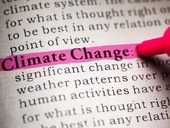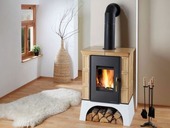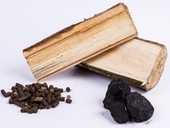This paper deals with investigation of the relationship between calculated and on-site measured values of energetic parameters in a zero house built in Slovakia. Energy consumption of a zero house is currently being discussed and examined from the viewpoint of energy consumption and comfort of the house residents. The paper investigates the differences between the results of simulation models and calculated values and real data on consumption. All the values are compared to the values measured by DTHL Klima Logger device and Wohler CDL 210 device to measure levels of CO2, and the data taken from a heat pump and a recuperation unit related to the residents’ behaviour records. The results show that energy consumption was influenced significantly by residents’ behaviour, setting of inner temperature besides airtightness of the outer envelope and window fillings. Based on the research results the construction of a zero house can be considered a standard option in conditions of Slovakia.
Archiv článků od 7.7.2014 do 24.11.2014
Waste water that ends up in the sewer network contains a large amount of energy. Utilization of this energy, which is also available throughout whole year, is not yet part of the standard engineering practice in the Czech Republic. This article brings an inspiration in the form of experience from Austrian city of Amstetten, where was implemented a project, which is using combination of a sewage heat exchanger and a heat pump. State of the art as the same as the factors affecting the utilization of waste heat are also included.
Described as the greenest commercial building in the world, the Bullitt Center in Seattle, Washington pushes the envelope in urban sustainability. The six-story, 52,000-square-foot structure is designed to meet stringent requirements of the Living Building Challenge (LBC)—using photovoltaic cells to generate enough electricity to sustain the needs of its tenants, recycling its own water and waste, and reducing energy use by more than 80 percent compared to an average office building.
LBC requirements stipulated that the Bullitt Center meet a number of criteria, including responsible site selection, 100 percent on-site renewable energy generation, 100 percent of water needs provided by harvested rainwater, and on-site waste management.
The aim is to lower CO2 emissions and reduce the environmental footprint of the building. Target life cycle 250-year is a key part of that goal.
The highest representatives of more than 120 countries accepted the invitation to the UN Climate Summit 2014. In addition to these UN Secretary General Ban Ki-moon invited representatives of financial and commercial institutions and civil society. The aim was to encourage and accelerate climate action. Ban Ki-moon requested them to announce bold measures and actions to reduce emissions, strengthen climate resilience and mobilize political will towards meaningful legal agreement in 2015.
Representatives of Countries presented their statements, but only rarely there was mentioned a specific reduction in CO2 emissions. Generally it can be said that most states are willing to contribute to reducing CO2 emissions “appropriately”. The question is what this word means in their imagination.
Having your own home fireplace or stove wants more and more users. Indoor heaters are a hit in recent years. In 2013, the Czech Republic has sold more than 22,000 different interior furnaces primarily on wood. About a quarter of the new owners then voted fireplace or stove with heat exchanger, thus such a source that can heat the whole flat or low-energy house. Some have even reached for the most comfortable way of using wood in the interior - automatic wood pellet stoves.
Existing lapses and mistakes during renewable energy sources development planning can be now avoided via unique program called RESTEP. RESTEP can easilly find available resources at given area and determine whether it is worthwhile to use them or not. Aim of this article is to introduce RESTEP, what it is good for, how does it work, who developes it and who will benefit from it.
Data needed for planning of energy use of RES are now available in one place through interactive map called RESTEP (regional sustainable energy policy). Authors describe RESTEP as RSA - regional source assessment. RESTEP recognizes what renewable energy soureces the selected location can offer, and then this potential derives a proposal of optimal mix of energy technologies. RESTEP is being developed at the Czech Agricultural University in Prague in cooperation with the Ministry of Environment and a number of other institutions.
The emergence of the working colonies of coffee plantations in Nicaragua is one of the most interesting construction projects in which is utilized the “Grow Your Own House” theory. In 2008, a Spanish design office developed a project based on environmental principles with the use of local material resources and subsequently there was built a self-sufficient colony Santa Emilia for coffee plantation workers in Matgapalga, Nicaragua.
The history of photovoltaic begins with the discovery of the photoelectric effect in 1839 and later the photovoltaic effect in 1876. Practical application of photovoltaics came a century later, the earliest for power supply of satellites in 1958.
Turbulent development of the field followed, accompanied by the rapid decline in prices and increase of energy efficiency.
Which buildings can receive grants from the Green Savings Programme, amount of the grants and what technical details cover the energy audit? Part A in this article covers the specific questions (building’s envelope rennovation). A sample of 16 family houses that comply with all the required conditions of the New Green Saving Programme from 2013 is further described in this article.
How to develop overall sales and preferences in the field of radiators in the Czech Republic? This is the question we try to answer every year with the help of sales performance evaluation of this business segment. Input data (for the period 2005–2013) we obtained from the Association of heating technology (APTT).
The concept of biomass plants can include cereal straw, rape straw, wood energy and energy crops. Herbs for energy use are annual and perennial. Among the perennial energy crops can include energy grass. Research and use of energy grasses are explored in this article. The research was conducted in two phases with a focus on identifying the most appropriate grass species for energy purposes, the optimal harvest time of grasses for energy production and utilization of grass for combustion.
Authors are engaged in the description and modeling of stagnancy situations in solar collectors when the possible output of heat from collectors cannot be utilized due to the excess of the produced heat, in their contribution. One of possibilities in such events is to shut the flow of the heat transfer medium and to let collectors in the stagnation when the energy balance between collector heat gains and their losses occur; eventually heat losses of the system pipelines linked directly to the collector field. In this situation in most of cases in systems equipped with quality solar collectors occurs the evaporation of the heat transfer medium. Used anti-freeze mixtures established on the basis of water solution of propylene glycol fall to so called zeotropic mixtures that have the evaporation temperature process different from the evaporation process of pure water or other pure matters. Authors describe both individual phases of this stagnation and behavior analysis of systems with the different ratio of the capacity of collectors and the expansion vessel, in their contribution.
The author deals with different combustible properties of biomass and coal. He describes specific approaches to combustion and fabrication of burners and to the method of burning air supply, in particular. He applies himself to new legislative requirements for small heat sources ensuing from the novelty of Act on Environmental Air Protection.
The paper shows a comparison of the influence of radiant cooling/heating and air conditioning on indoor environment. Cooling and heating based on thermally activated structures is a viable option of maintaining optimum thermal conditions without great demands on energy consumption. Presented system uses phase change materials (PCMs) as a latent heat storage medium for better absorption of heat. Microencapsulated PCMs Micronal® DS 5040 X and DS 5008 X were used as latent heat storage medium in combination with gypsum plaster. Activation of phase change materials is carried out by capillary tubes with cooled / heated water circuit. Detailed investigation is performed in the test rooms for comparative measurements. Radiant cooling and heating are one of the ways to reduce energy consumption and operating cost for cooling / heating. The Differential Scanning Calorimetry (DSC) was used for thermal analysis of the latent heat storage medium.
Year 2013 was important in terms of sales of heat sources in the Czech Republic, because the long-awaited change came after years in the sign of declining demand. Sales of manufacturers grew significantly, as it documents the evaluation of the data obtained from the Association of heating technology (APTT) and the Ministry of Industry and Trade (MPO).
By Directive 2009/28/ES on the promotion of the use of energy from renewable sources, Member States shall ensure that certification schemes or equivalent qualification schemes become or are available for installers of small-scale RES (biomass boilers and stoves, solar photovoltaic and solar thermal systems, shallow geothermal systems and heat pumps). The directive does not imply that a person with no certification could not install the small-scale RES.
Contrary to that the Act No. 406/2000 Coll., on Energy Management (as amended by Act No. 318/2012 Coll.) implies that small-scale renewable energy sources may only be installed by person with appropriate permission. Paradoxically, even though for the installation of a biomass boiler is required permission, fossil fuel boilers can be installed in the Czech Republic without authorization. This is in direct conflict with the intent of the Directive.
zpět na aktuální články



















